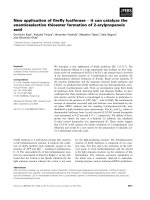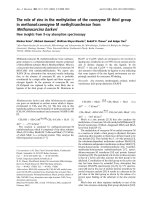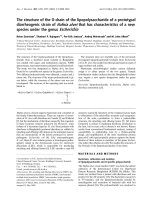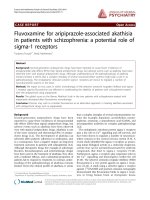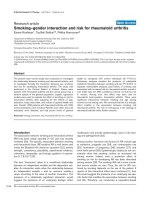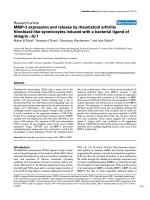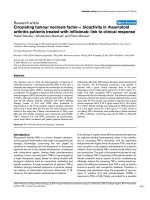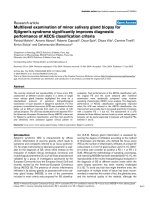Báo cáo y học: "New classification of HLA-DRB1 alleles in rheumatoid arthritis susceptibility: a combined analysis of worldwide samples" docx
Bạn đang xem bản rút gọn của tài liệu. Xem và tải ngay bản đầy đủ của tài liệu tại đây (618.16 KB, 8 trang )
Open Access
Available online />Page 1 of 8
(page number not for citation purposes)
Vol 10 No 1
Research article
New classification of HLA-DRB1 alleles in rheumatoid arthritis
susceptibility: a combined analysis of worldwide samples
Thomas Barnetche
1
, Arnaud Constantin
1,2
, Alain Cantagrel
2,3
, Anne Cambon-Thomsen
1
and
Pierre-Antoine Gourraud
1,4
1
Department of Epidemiology and Public Health, UMR Inserm U 558, University Paul Sabatier Toulouse III, Faculty of Medicine Purpan, 37 Allées
Jules Guesde, Toulouse cedex 7, 31073, France
2
Rheumatology Department, Larrey University Hospital, 24 chemin de Pouvourville, Toulouse cedex 9, 31059, France
3
JE2510, University Paul Sabatier Toulouse III, 118 route de Narbonne, Toulouse, 31062 cedex 9, France
4
UF de Méthodologie de la recherche clinique, Epidemioloy Unit, Toulouse University Hospital, 37 Allées Jules Guesde, Toulouse cedex 7, 31073,
France
Corresponding author: Pierre-Antoine Gourraud,
Received: 19 Sep 2007 Revisions requested: 19 Oct 2007 Revisions received: 12 Dec 2007 Accepted: 28 Feb 2008 Published: 28 Feb 2008
Arthritis Research & Therapy 2008, 10:R26 (doi:10.1186/ar2379)
This article is online at: />© 2008 Barnetche et al.; licensee BioMed Central Ltd.
This is an open access article distributed under the terms of the Creative Commons Attribution License ( />),
which permits unrestricted use, distribution, and reproduction in any medium, provided the original work is properly cited.
Abstract
Introduction Rheumatoid arthritis (RA) is a complex polygenic
disease of unknown etiology. HLA-DRB1 alleles encoding the
shared epitope (SE) (RAA amino acid pattern in positions 72 to
74 of the third hypervariable region of the DRβ1 chain) are
associated with RA susceptibility. A new classification of HLA-
DRB1 SE alleles has been developed by Tezenas du Montcel
and colleagues to refine the association between HLA-DRB1
and RA. In the present study, we used RA samples collected
worldwide to investigate the relevance of this new HLA-DRB1
classification in terms of RA susceptibility across various
Caucasoid and non-Caucasoid patients.
Methods Eighteen subsamples were defined from a total
number of 759 cases and 789 controls and grouped in 10
samples on the basis of their ethnic origin. HLA-DRB1 alleles
were divided into five groups (S
1
, S
2
, S
3D
, S
3P
, and X) according
to the new HLA-DRB1 allele classification. The whole analysis
was performed by comparing carrier frequencies for the five
HLA-DRB1 allele groups between RA patients and controls
across the 10 Caucasoid and non-Caucasoid samples. The
Mantel-Haenszel method of meta-analysis provided a global
odds ratio (OR) estimate with 95% confidence interval (CI).
Results A positive association with RA susceptibility was found
for S
2
allele carriers (OR 2.15, 95% CI 1.54 to 3.00; p < 10
-5
)
and S
3P
allele carriers (OR 2.74, 95% CI 2.01 to 3.74; p < 10
-
5
). A negative association was found for S
1
alleles (OR 0.60,
95% CI 0.48 to 0.76; p < 10
-4
) and X alleles (OR 0.58, 95% CI
0.39 to 0.84; p = 4 × 10
-3
). No significant association was
highlighted for the S
3D
group of alleles (OR 0.89, 95% CI 0.69
to 1.14; p = 0.89). The complementary genotype analysis fit with
the genotype risk hierarchy previously reported in Caucasoid RA
patients.
Conclusion So far, the present study is the first attempt to
investigate the relevance of this new HLA-DRB1 classification
in terms of RA susceptibility on both Caucasoid and non-
Caucasoid samples. Our results support the hypothesis of a
differential role played by different HLA-DRB1 allele groups in
RA susceptibility across different ethnic backgrounds and
confirm the interest of such an HLA-DRB1 classification in
differentiating predisposing and protective alleles.
Introduction
Rheumatoid arthritis (RA) is the most frequent chronic inflam-
matory rheumatic disease in the world, with prevalence esti-
mates of 0.25% to 0.5%. Its pathogenesis is multifactorial and
genetic factors may contribute for 40% to 60% of the total risk
[1]. Among possible genetic factors, the HLA-DRB1 gene
appears clearly associated with RA [2]. This association was
first suggested more than 30 years ago [3] and was elabo-
rated 10 years later by Gregersen and colleagues [4], who
demonstrated that RA was associated with several HLA-
Anti-CCP = anti-cyclic citrullinated peptide; CI = confidence interval; IHWG = International Histocompatibility Working Group; OR = odds ratio; RA
= rheumatoid arthritis; SE = shared epitope.
Arthritis Research & Therapy Vol 10 No 1 Barnetche et al.
Page 2 of 8
(page number not for citation purposes)
DRB1 alleles (DRB1*0101, DRB1*0102, DRB1*0401,
DRB1*0404, DRB1*0405, DRB1*0408, DRB1*1001, and
DRB1*1402) encoding the RAA sequence of amino acids at
positions 72 to 74 in the third hypervariable region of the
DR
β
1 chain, known as the shared epitope (SE). Despite sig-
nificant improvement in molecular biology techniques, associ-
ation mechanisms between HLA-DRB1*SE
+
alleles and RA
remain debated and authors have demonstrated that each SE
allele does not confer the same risk [4-6].
In a more recent study, Tezenas du Montcel and colleagues
[8] advanced a new classification of HLA-DRB1 alleles,
reconsidering the SE model in RA susceptibility. According to
this new classification, the susceptibility to RA, which
depends on whether the RAA sequence occupies positions
72 to 74, was modulated by the amino acids at positions 70
and 71, which led to the definition of five groups of HLA-
DRB1 alleles: S
1
, S
2
, S
3P
, S
3D
, and X alleles. Michou and col-
leagues [9] tested and validated this new classification in an
independent sample of 100 French Caucasoid RA trio fami-
lies, providing estimates for the susceptibility risk genotypes.
In the present study, we used worldwide RA samples from the
13th International Histocompatibility Working Group (IHWG)
to investigate the relevance of this new HLA-DRB1 allele clas-
sification in terms of RA susceptibility across various Cauca-
soid and non-Caucasoid population samples.
Materials and methods
Selection process of case and control population
samples
RA cases and healthy controls included in the present study
were selected from a population of 2,376 individuals (1,210
cases and 1,166 controls), initially gathered by 19 laboratories
in 17 countries in the framework of the 13th IHWG. The data
are publicly available from the dbMHC (Major Histocompatibil-
ity Complex database) website of the National Center for Bio-
technology Information (Bethesda, MD, USA) [7]. All RA
cases met the following criteria: adult onset RA (by definition,
16 years of age or older) and the American College of Rheu-
matology criteria for RA [8]. For each laboratory, healthy con-
trols were selected within the same geographical area as the
RA cases. A selection procedure of cases and controls was
carried out in order to allow the comparison of the data issued
from the different laboratories that participated in the 13th
IHWG: (a) cases and controls of undocumented origin were
excluded, (b) samples consisting of cases without controls
and samples of less than 20 individuals were discarded, and
(c) cases and controls that were matched beforehand for spe-
cific HLA-DRB1–HLA-DQB1 haplotypes were excluded.
Data from different submitters consisting of individuals from
the same origin were pooled when no significant departures
were found as assessed by an admixture test, which asymptot-
ically follows a chi-square distribution with 1 degree of free-
dom. According to this selection procedure, 758 cases and
789 controls, issued from 10 different ethnic origin subsam-
ples, were included in the present study (Table 1).
HLA-DRB1 genotyping
All RA cases and controls were genotyped for HLA-DRB1.
HLA-DRB1 typing techniques used in the framework of the
13th IHWG are described extensively in the 13th IHWG Pro-
ceedings [9,10].
HLA-DRB1 classification
HLA-DRB1 alleles were divided into five groups according to
the classification proposed by Tezenas du Montcel and col-
leagues [11,12]. Briefly, the HLA-DRB1 alleles were first
divided into two groups according to the presence or absence
of the RAA sequence at positions 72 to 74 and were denoted
S and X alleles, respectively. The S alleles were subsequently
divided into three groups according to the amino acid (alanine
[A], glutamic acid [E], lysine [K], or arginine [R]) at position 71:
S
1
for ARAA and ERAA, S
2
for KRAA, and S
3
for RRAA. Since
an aspartic acid (D) at position 70 was reported to be protec-
tive against RA in contrast to a glutamine (Q) or an arginine (R)
at the same position [13], two additional groups were defined:
S
3D
for DRRAA and S
3P
for QRRAA or RRRAA [11,12].
Statistical analysis
To identify association with RA susceptibility, odds ratios
(ORs) were calculated for the presence of the S
1
, S
2
, S
3P
, S
3D
,
and X alleles. Confidence intervals (CIs) are given at 95% con-
fidence. Consistently with previous findings [7-9] and with the
main objective of this work (which is to challenge these previ-
ous findings in various Caucasoid and non-Caucasoid popula-
tions), we performed the whole analysis under a dominant
effect model by comparing carrier frequencies for the different
HLA-DRB1 allele groups defined according to the classifica-
tion between RA patients and controls across the 10 Cauca-
soid and non-Caucasoid samples.
We used a meta-analysis approach to combine the data
issued from the different laboratories that participated in the
13th IHWG. The Mantel-Haenszel method assumes a fixed
effect and combines studies using a method similar to inverse
variance approaches to determine the weight given to each
study. It provides a common OR estimate, taking into account
the weight of the different samples and 95% CI. OR and 95%
CI are shown on forest plots for each allele group studied. Sta-
tistical heterogeneity of the considered samples was
assessed on the basis of the Q test (chi-square), using a sig-
nificance level of 0.05, and reported with the I
2
statistic (in
which high values indicate high heterogeneity). An I
2
value of
greater than 50% was considered the threshold for heteroge-
neity. Genotype risk analyses were conducted using the same
method. All computations were performed using the Revman
4.2.8 software package developed by the Nordic Cochrane
Center (Copenhagen, Denmark) [14] and Stata version 7.0
software (StataCorp LP, College Station, TX, USA). All p val-
Available online />Page 3 of 8
(page number not for citation purposes)
ues were two-sided. P values of less than 0.05 were consid-
ered significant, and corrections for multiple testing were
mentioned when relevant.
Results
Carrier frequencies of the different HLA-DRB1 allele
groups in RA cases and controls for the various
Caucasoid and non-Caucasoid population samples
Figure 1 shows the carrier frequencies for the different HLA-
DRB1 allele groups, as defined according to the classification
developed by Tezenas du Montcel and colleagues [11], in
cases and controls of each sample selected from the 13th
IHWG. No significant departures from Hardy-Weinberg equi-
librium were observed (all p > 0.05 after correction for multiple
testing). Statistical testing for heterogeneity in the X allele
group revealed a significant difference between samples (I
2
=
62.9%, p = 4 × 10
-3
). No significant heterogeneity could be
observed for the S
1
(I
2
= 0%, p = 0.57), S
2
(I
2
= 15.9%, p =
0.30), S
3P
(I
2
= 19.5%, p = 0.27), or S
3D
(I
2
= 23.6%, p = 0.23)
groups of HLA-DRB1 alleles.
Carrier frequency comparisons of the different HLA-
DRB1 allele groups between RA cases and controls
across the various Caucasoid and non-Caucasoid
population samples and overall effect estimation
Results of allele carrier frequency comparisons between RA
cases and controls across the various Caucasoid and non-
Caucasoid population samples are presented in Figure 1. An
overall positive association with RA susceptibility was found
for S
2
alleles (OR 2.15, 95% CI 1.54 to 3.00; p < 10
-5
) and
S
3P
alleles (OR 2.74, 95% CI 2.01 to 3.74; p < 10
-5
). An over-
all negative association with RA susceptibility was highlighted
for S
1
alleles (OR 0.60, 95% CI 0.48 to 0.76; p < 10
-4
) and X
alleles (OR 0.58, 95% CI 0.39 to 0.84; p = 4 × 10
-3
). No sig-
nificant association with RA susceptibility was found for the
S
3D
group of alleles (OR 0.89, 95% CI 0.69 to 1.14; p = 0.88).
In such an analysis, a potential bias may be introduced by the
presence of allele adverse effect in the control group. For
example, in the analysis of the S
2
effect, the association may
be overestimated due to the presence of S
3D
carriers in the
control group (noncarrier of S
2
). Similarly, the effect of S
2
may
be underestimated thanks to the presence of S
3P
carriers.
After controlling for the adverse effect of S
3D
and S
1
in the
analysis of S
2
, the association with RA susceptibility remained
significant (p < 0.05).
Carrier frequency comparisons of the different HLA-
DRB1 allele groups between RA cases and controls in
Caucasoid and non-Caucasoid population samples
Results of allele carrier frequency comparisons between RA
cases and controls in Caucasoid and non-Caucasoid popula-
tion samples are presented in Table 2. In the Caucasoid pop-
ulation sample, S
2
alleles (OR 2.61, 95% CI 1.87 to 3.64) and
S
3P
alleles (OR 1.86, 95% CI 1.39 to 2.49) were positively
associated with RA susceptibility, whereas S
1
alleles (OR
0.59, 95% CI 0.45 to 0.79) and X alleles (OR 0.74, 95% CI
0.56 to 0.96) were negatively associated with RA susceptibil-
ity. In the non-Caucasoid population sample, S
3P
alleles (OR
2.93, 95% CI 2.21 to 4.04) were positively associated with
RA susceptibility, whereas S
1
alleles (OR 0.52, 95% CI 0.37
to 0.71) and X alleles (OR 0.61, 95% CI 0.45 to 0.83) were
negatively associated with RA susceptibility.
Overall effect estimation of genotypes resulting from the
classification of HLA-DRB1 alleles on RA susceptibility
Using the approach proposed by Michou and colleagues [9],
we further pooled the three low-risk allele groups (S
1
, S
3D
, and
X), thus producing a new grouping called L alleles. Thus, in
Table 1
Composition of the selected rheumatoid arthritis case and control population samples
Ancestry Sample origin Number of cases Number of controls
Caucasian Greek 37 31
Caucasian Spanish 141 234
Caucasian American (Whites) 206 105
Amerindian North American (Amerinds) 98 78
African-American North American (Blacks) 46 51
African San (Bushman) 23 57
Asian Korean 81 68
Asian Chinese 21 20
Asian Javanese 66 72
Slavic Russian 40 73
Total 759 789
These data were extracted from the 13th International Histocompatibility Working Group rheumatoid arthritis samples and are available on the
National Center for Biotechnology Information website [28]. For the sample selection procedure, please refer to the Materials and methods
section of this article.
Arthritis Research & Therapy Vol 10 No 1 Barnetche et al.
Page 4 of 8
(page number not for citation purposes)
Figure 1
Carrier frequency comparisons of the different HLA-DRB1 allele groups between rheumatoid arthritis (RA) cases and controls across the various Caucasoid and non-Caucasoid population samples and overall effect estimationCarrier frequency comparisons of the different HLA-DRB1 allele groups between rheumatoid arthritis (RA) cases and controls across the various
Caucasoid and non-Caucasoid population samples and overall effect estimation. This figure provides a summary meta-analysis of allele carrier fre-
quencies according to HLA-DRB1 allele classification, in selected samples among the data available from the 13th International Histocompatibility
Working Group on Rheumatoid Arthritis. For each population sample, odds ratios (ORs) and 95% confidence intervals (95% CIs) evaluate the sig-
nificance of the association between the different HLA-DRB1 allele groups and RA susceptibility (blue boxes). The combined ORs and 95% CIs
evaluate the significance of the global effect of the different HLA-DRB1 allele groups on RA susceptibility over all population samples. P values were
calculated with the Mantel-Haenszel method (black diamonds).
Available online />Page 5 of 8
(page number not for citation purposes)
subsequent analyses, we considered only three allele groups
(S
2
, S
3P
, and L alleles), with six corresponding genotypes [12].
The results of observed genotype distributions and of
genotype relative risks are shown in Table 3. S
2
/S
3P
and S
3P
/
S
3P
were associated with the greatest risks for RA, with ORs
(95% CIs) of 7.25 (3.26 to 16.14) and 5.15 (2.91 to 9.12),
respectively. These are followed by S
2
/S
2
, S
2
/L, and S
3P
/L,
with ORs (95% CIs) of 4.95 (2.2 to 11.18), 2.41 (1.60 to
3.65), and 2.33 (1.57 to 3.45), respectively. These analyses
were all performed using the L/L genotype as reference.
Table 2
Carrier frequency comparisons of the different HLA-DRB1 allele groups between rheumatoid arthritis cases and controls in
Caucasoid and non-Caucasoid population samples
RA cases, n (%) Controls, n (%) OR (95% CI)
S
1
alleles
Caucasoids 125 (29.4%) 183 (41.3%) 0.59 (0.45–0.79)
Non-Caucasoids 87 (26%) 140 (40%) 0.52 (0.37–0.71)
S
2
alleles
Caucasoids 133 (31%) 66 (15%) 2.61 (1.87–3.64)
Non-Caucasoids 48 (14%) 37 (11%) 1.40 (0.88–2.21)
S
3D
alleles
Caucasoids 123 (29%) 159 (36%) 0.73 (0.55–0.97)
Non-Caucasoids 112 (33%) 120 (35%) 0.95 (0.69–1.30)
S
3P
alleles
Caucasoids 159 (37.5%) 108 (24%) 1.86 (1.39–2.49)
Non-Caucasoids 170 (51%) 90 (26%) 2.93 (2.12–4.04)
X alleles
Caucasoids 201 (47%) 244 (55%) 0.74 (0.56–0.96)
Non-Caucasoids 145 (43%) 192 (55%) 0.61 (0.45–0.83)
The Caucasoid sample population refers to the combination of the following population samples: Greek, Spanish, Russian, and American
(Whites). The non-Caucasoid sample population refers to the combination of the following population samples: North American (Amerinds), North
American (Blacks), Bushmen, Korean, Chinese, and Javanese. The combined odds ratios (ORs) and 95% confidence intervals (CIs) evaluate the
significance of the global effect of the different HLA-DRB1 allele groups on rheumatoid arthritis (RA) susceptibility in Caucasoids and non-
Caucasoids.
Table 3
Overall effect estimation of genotypes resulting from the classification of HLA-DRB1 alleles on rheumatoid arthritis susceptibility
Genotypes Genotype distribution, n (%) OR (95% CI) P values
RA cases, n = 758 Controls, n = 789
S
2
/S
3P
39 (5.1%) 7 (0.9%) 7.25 (3.26–16.14) <10
-5
S
3P
/S
3P
74 (9.8%) 31 (4%) 5.15 (2.91–9.12) <10
-5
S
2
/S
2
24 (3.2%) 8 (1%) 4.95 (2.2–11.18) <10
-4
S
2
/L 121 (16%) 78 (9.9%) 2.41 (1.60–3.65) <10
-4
S
3P
/L 179 (23.6%) 136 (17.2%) 2.33 (1.57–3.45) <10
-4
L/L 321 (42.3%) 529 (67%) 1
S
1
, S
2
, S
3P
, S
3D
, and X allele groups were defined according to the amino acid sequence at positions 70 to 74. According to the approach
proposed by Michou and colleagues [9], we pooled the three low-risk allele groups (S
1
, S
3D
, and X), so called L alleles. Thus, in subsequent
analyses, we considered only three allele groups (S
2
, S
3P
, and L alleles), with six corresponding genotypes [12]. The reference genotype is L/L.
The combined odds ratios (ORs) and 95% confidence intervals (CIs) evaluate the significance of the global effect of the different HLA-DRB1
genotype groups on rheumatoid arthritis (RA) susceptibility over all population samples. P values were calculated with the Mantel-Haenszel
method.
Arthritis Research & Therapy Vol 10 No 1 Barnetche et al.
Page 6 of 8
(page number not for citation purposes)
Discussion
In the present association study, we investigated the relevance
of the classification of HLA-DRB1 alleles proposed by Teze-
nas du Montcel and colleagues [11] regarding susceptibility to
RA, across various Caucasoid and non-Caucasoid population
samples, using publicly available data from the 13th IHWG RA
studies. Across these various population samples, our
approach strengthens the relevance of this classification,
exhibiting an overall positive association with RA susceptibility
for S
2
and S
3P
alleles and an overall negative association with
RA susceptibility for S
1
and X alleles. The genotype analysis
performed in the present study fits with the genotype risk hier-
archy previously reported in Caucasoid RA sporadic cases
[11] and families [12].
The present combined analysis included 10 samples from dif-
ferent genetic backgrounds. Although we did not observe sig-
nificant heterogeneity for S
1
, S
2
, S
3D
and S
3P
allele groups, we
observed significant heterogeneity for the X allele group
across the different population samples. The fixed effect
model of the Mantel-Haenszel method, used for the overall
effect analysis of the HLA-DRB1 allele and genotype groups
on RA susceptibility in the present study, assumes that each
allele group carries out a homogeneous effect on RA suscep-
tibility across the various Caucasoid and non-Caucasoid sam-
ples. The heterogeneity observed for the X allele group may be
questioned according the heterogeneity of the HLA-DRB1
allele and genotype groups at two levels across the different
population samples: the effect level and the frequency level.
Our data suggest that there is a differential effect of the S
1
, S
2
,
S
3D
and S
3P
allele groups on RA susceptibility. Each of these
effects seems homogenous across the various population
samples. Because the SE allele distribution varies across
these populations, the resulting effect of the X allele group on
RA susceptibility depends both on the frequency of the S
1
, S
2
,
S
3D
and S
3P
allele groups, and their respective effects on RA
susceptibility, which might explain the observed heterogeneity
of the effect of the X allele group in our study.
The contribution of SE alleles to RA susceptibility has been
confirmed by numerous studies on different populations. For
example, a recent meta-analysis on Latin American RA
patients has shown the important role played by SE in RA sus-
ceptibility [15]. However, RA prevalence studies have shown
differences in frequency estimations between populations
with different genetic backgrounds. The highest prevalence
rates have been found in Native American populations with
estimation ranges of 32 to 48 per 1,000 men and 59 to 70 per
1,000 women. In Afro-Caribbean people who live in the UK,
RA prevalence appeared to be lower than that in the general
population. In urban African populations, RA prevalence was
estimated around 10 per 1,000 and was found to be signifi-
cantly higher than in rural populations. Studies on Chinese
populations have reported lower prevalence estimations than
in European ones. Molokhia and McKeigue previously pointed
out the difficulty brought up by admixture in investigating the
etiology of rheumatic diseases, notably for RA [16]. The signif-
icant variations observed in the incidence and prevalence of
RA among different populations or ethnic groups could be
explained, in part, by genetic variations in the HLA region,
especially variations in the prevalence of SE in different popu-
lations [17,18]. In addition, as no consideration of
environmental exposure variations between the population
samples studied was made, the heterogeneity could be
explained by the different impact of environmental factors on
RA susceptibility in each different sample, such as nutrition as
previously suggested, in particular in the Greek population
[18,19]. In addition to nutrition, environmental factors such as
exposure to cigarette smoking [20,21] or individual factors
such as gender [22] may influence susceptibility to RA by
interacting with genetic factors such as HLA-DRB1.
The classification proposed by Tezenas du Montcel and col-
leagues [11], based on amino acid sequence at positions 70
to 74, does not aim to account for all previously reported asso-
ciations between particular HLA-DRB1 alleles and RA sus-
ceptibility in specific ethnic backgrounds. For example, the
previously reported association between the HLA-
DRB1*0901 allele and RA susceptibility in East Asian popula-
tions could not be tested in the present study, as this particular
allele was classified together with many others as an X allele
[23-25]. The high frequency of the HLA-DRB1*0901 allele in
the Javanese population could contribute both to the associa-
tion found between X alleles and susceptibility to RA in this
particular population sample and to the observed heterogene-
ity of the X allele group.
The contribution of the HLA-DRB1 allele classification in
accounting for the genetic contribution of the HLA-DRB1
gene was previously analyzed in terms of RA severity and in
terms of autoantibody production such as anti-cyclic citrulli-
nated peptide (anti-CCP) antibodies and anti-deiminated
human fibrinogen autoantibodies. As RA severity outcomes as
well as anti-CPP information were not collected in the frame-
work of the 13th IHWG, we were not able to discuss the rele-
vance of the classification of HLA-DRB1 alleles proposed by
Tezenas du Montcel and colleagues [8] regarding RA severity
or autoantibody production in the various Caucasoid and non-
Caucasoid population samples included in the present study.
Conclusion
Across these various samples coming from both Caucasoid
and non-Caucasoid populations, we investigated the
relevance of the classification of HLA-DRB1 alleles proposed
by Tezenas du Montcel and colleagues [11] regarding sus-
ceptibility to RA. We confirm previous findings on the contri-
bution of the S
2
and S
3P
risk allele groups to RA susceptibility.
In spite of the small sample size in some ethnic groups, the
present study allows the differentiation between predisposing
Available online />Page 7 of 8
(page number not for citation purposes)
and protective HLA-DRB1 SE alleles in both Caucasoid and
non-Caucasoid RA patients.
This report also emphasized the very crucial importance of
public release of large-scale study data in genetic epidemiol-
ogy. The need for large samples to refine the study of effects
of modest magnitude and the necessity to replicate studies
across different ethnic backgrounds rely on easy access to a
large variety of data organized in a systematic way. After an ini-
tial period of restricted use of the data by the initial investiga-
tors, the access to clinical and genetic anonymous individual
data should be made possible; this is the current policy of the
National Institutes of Health (Bethesda, MD, USA) for
genome-wide association study results [26]. Combined with a
detailed description of the sampling scheme for both patients
and controls, advanced statistical analysis will contribute to
enhance secondary uses of data valorizing the efforts of previ-
ously completed studies [27].
Competing interests
The authors declare that they have no competing interests.
Authors' contributions
TB, ACo, and P-AG took the leadership of the study in both
immunological and statistical aspects. ACa contributed
through the assessment of clinical aspects. AC-T contributed
to the statistical analysis. All authors read and approved the
final manuscript.
Acknowledgements
The authors wish to gratefully acknowledge the contributions of John
Hansen and Lee Nelson at the Fred Hutchinson Cancer Research
Center (Seattle, WA, USA) and Mike Feolo and the dbMHC (major his-
tocompatibility complex database) team at the National Center for Bio-
technology Information (Bethesda, MD, USA) and the help of technical
and clinical collaborators from the rheumatoid arthritis international
working group, for clinical data management and laboratory typings. The
authors are indebted to patients and controls for their kind participation.
All of these contributions were invaluable for the setting up of the data-
base used in this article. Infrastructures and facilities from Institut
National de la Santé et de la recherche médicale Inserm, Unit 558, Tou-
louse, and from University Paul Sabatier Toulouse III were used, in par-
ticular the TIERSMIP platform for managing multi-site clinical research
data management and analysis. The authors were supported by the fol-
lowing institutions: Institut National de la Santé et de la recherche médi-
cale: INSERM, Unit 558, Toulouse, France (P-AG, AC-T, and AC);
Centre National de la Recherche Scientifique (AC-T); Department of
Rheumatology (AC); Department of Epidemiology (P-AG); and Univer-
sity Hospital, Bordeaux (TB).
References
1. Silman AJ, MacGregor AJ, Thomson W, Holligan S, Carthy D,
Farhan A, Ollier WE: Twin concordance rates for rheumatoid
arthritis: results from a nationwide study. Br J Rheumatol
1993, 32:903-907.
2. Newton JL, Harney SM, Wordsworth BP, Brown MA: A review of
the MHC genetics of rheumatoid arthritis. Genes Immun 2004,
5:151-157.
3. Stastny P: Mixed lymphocyte cultures in rheumatoid arthritis. J
Clin Invest 1976, 57:1148-1157.
4. Korendowych E, Dixey J, Cox B, Jones S, McHugh N: The Influ-
ence of the HLA-DRB1 rheumatoid arthritis shared epitope on
the clinical characteristics and radiological outcome of psori-
atic arthritis. J Rheumatol 2003, 30:96-101.
5. Génin E, Babron MC, McDermott MF, Mulcahy B, Waldron-Lynch
F, Adams C, Clegg DO, Ward RH, Shanahan F, Molloy MG,
O'Gara F, Clerget-Darpoux F: Modelling the major histocompat-
ibility complex susceptibility to RA using the MASC method.
Genetic Epidemiology 1998, 15:419-430.
6. Tézenas du Montcel S, Reviron D, Genin E, Roudier J, Mercier P,
Clerget-Darpoux F: Modeling the HLA component in rheuma-
toid arthritis: sensitivity to DRB1 allele frequencies. Genet
Epidemiol 2000, 19:422-428.
7. Wheeler DL, Barrett T, Benson DA, Bryant SH, Canese K,
Chetvernin V, Church DM, DiCuccio M, Edgar R, Federhen S,
Geer LY, Kapustin Y, Khovayko O, Landsman D, Lipman DJ, Mad-
den TL, Maglott DR, Ostell J, Miller V, Pruitt KD, Schuler GD,
Sequeira E, Sherry ST, Sirotkin K, Souvorov A, Starchenko G,
Tatusov RL, Tatusova TA, Wagner L, Yaschenko E: Database
resources of the National Center for Biotechnology
Information. Nucleic Acids Res 2007, 35:D5-12.
8. Arnett Frank C, Edworthy Steven M, Bloch Daniel A, Mcshane
Dennis J, Fries James F, Cooper Norman S, Healey Louis A, Kaplan
Stephen R, Liang Matthew H, Luthra Harvinder S, Medsger Tho-
mas A Jr, Mitchell Donald M, Neustadt David H, Pinals Robert S,
Schaller Jane G, Sharp John T, Wilder Ronald L, Hunder Gene G:
The American Rheumatism Association 1987 revised criteria
for the classification of rheumatoid arthritis. Arthritis Rheum
1988, 31:315-324.
9. Hansen JA, Dupont B: HLA 2004: Immunobiology of the Human
MHC. Proceedings of the 13th International Histocompatibility
Workshop and Congress. Volume I & II. IHWG press, Seattle,
WA; 2004.
10. Tilanus MGJ, Hansen JA, Hurley CK: IHWG Technical Manual –
Genomic analysis of the Human MHC, distributed by the Inter-
national Histocompatibility Working Group edn. Seattle: IHWG
press; 2002.
11. du Montcel ST, Michou L, Petit-Teixeira E, Osorio J, Lemaire I, Las-
bleiz S, Pierlot C, Quillet P, Bardin T, Prum B, Cornelis F, Clerget-
Darpoux F: New classification of HLA-DRB1 alleles supports
the shared epitope hypothesis of rheumatoid arthritis
susceptibility. Arthritis Rheum 2005, 52:1063-1068.
12. Michou L, Croiseau P, Petit-Teixeira E, du Montcel ST, Lemaire I,
Pierlot C, Osorio J, Frigui W, Lasbleiz S, Quillet P, Bardin T, Prum
B, Clerget-Darpoux F, Cornélis F, European Consortium on Rheu-
matoid Arthritis Families: Validation of the reshaped shared
epitope HLA-DRB1 classification in rheumatoid arthritis.
Arthritis Res Ther 2006, 8:R79.
13. Zanelli E, Breedveld FC, de Vries RR: HLA class II association
with rheumatoid arthritis: facts and interpretations. Hum
Immunol 2000, 61:1254-1261.
14. Review Manager (RevMan) [Computer program]. Version 4.2
for Windows. Copenhagen: The Nordic Cochrane Centre TCC;
2003.
15. Delgado-Vega AM, Anaya JM: Meta-analysis of HLA-DRB1 poly-
morphism in Latin American patients with rheumatoid arthritis.
Autoimmun Rev 2007, 6:402-408.
16. Molokhia M, McKeigue P: Risk for rheumatic disease in relation
to ethnicity and admixture. Arthritis Res 2000, 2:115-125.
17. Gorman JD, Lum RF, Chen JJ, Suarez-Almazor ME, Thomson G,
Criswell LA: Impact of shared epitope genotype and ethnicity
on erosive disease: a meta-analysis of 3,240 rheumatoid
arthritis patients. Arthritis Rheum 2004, 50:400-412.
18. Ioannidis JP, Tarassi K, Papadopoulos IA, Voulgari PV, Boki KA,
Papasteriades CA, Drosos AA: Shared epitopes and rheuma-
toid arthritis: disease associations in Greece and meta-analy-
sis of Mediterranean European populations. Semin Arthritis
Rheum 2002, 31:361-370.
19. Linos A, Kaklamani VG, Kaklamani E, Koumantaki Y, Giziaki E,
Papazoglou S, Mantzoros CS: Dietary factors in relation to rheu-
matoid arthritis: a role for olive oil and cooked vegetables?
Am J Clin Nutr 1999, 70:1077-1082.
20. Padyukov L, Silva C, Stolt P, Alfredsson L, Klareskog L: A gene-
environment interaction between smoking and shared epitope
genes in HLA-DR provides a high risk of seropositive rheuma-
toid arthritis. Arthritis Rheum 2004, 50:3085-3092.
Arthritis Research & Therapy Vol 10 No 1 Barnetche et al.
Page 8 of 8
(page number not for citation purposes)
21. Mattey DL, Hutchinson D: Smoking and HLA-DR shared epitope
alleles in rheumatoid arthritis: comment on the article by
Padyukov et al. Arthritis Rheum 2005, 52:3675-3676. author
reply 3676–3678
22. Meyer JM, Han J, Singh R, Moxley G: Sex influences on the pen-
etrance of HLA shared-epitope genotypes for rheumatoid
arthritis. Am J Hum Genet 1996, 58:371-383.
23. Kochi Y, Yamada R, Kobayashi K, Takahashi A, Suzuki A, Sekine A,
Mabuchi A, Akiyama F, Tsunoda T, Nakamura Y, Yamamoto K:
Analysis of single-nucleotide polymorphisms in Japanese
rheumatoid arthritis patients shows additional susceptibility
markers besides the classic shared epitope susceptibility
sequences. Arthritis Rheum 2004, 50:63-71.
24. Lee HS, Lee KW, Song GG, Kim HA, Kim SY, Bae SC: Increased
susceptibility to rheumatoid arthritis in Koreans heterozygous
for HLA-DRB1*0405 and *0901. Arthritis Rheum 2004,
50:3468-3475.
25. Wakitani S, Imoto K, Murata N, Toda Y, Ogawa R, Ochi T: The
homozygote of HLA-DRB1* not its heterozygote, is associated
with rheumatoid arthritis in Japanese. Scand J Rheumatol
0901, 27:381-382.
26. Fact Sheet on Genome Wide Association Studies (GWAS) pro-
posed policy [ />fact_sheet.htm]. (Last update: oct 6, 2006; last access date: July
23, 2007)
27. NCI-NHGRI Working Group on Replication in Association Stud-
ies, Chanock SJ, Manolio T, Boehnke M, Boerwinkle E, Hunter DJ,
Thomas G, Hirschhorn JN, Abecasis G, Altshuler D, Bailey-Wilson
JE, Brooks LD, Cardon LR, Daly M, Donnelly P, Fraumeni JF Jr, Fre-
imer NB, Gerhard DS, Gunter C, Guttmacher AE, Guyer MS, Har-
ris EL, Hoh J, Hoover R, Kong CA, Merikangas KR, Morton CC,
Palmer LJ, Phimister EG, Rice JP, Roberts J, et al.: Replicating
genotype-phenotype associations. Nature 2007, 447:655-660.
28. National Center for Biotechnology Information website [http:/
/www.ncbi.nlm.nih.gov]

